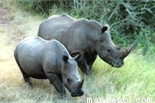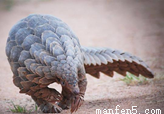题目内容


In 2013 alone at least 20,000 African elephants were killed for their teeth. In South Africa over the last two years more than 2,200 rhinos were killed for their horns. These numbers are alarming, because current rates of illegal hunting are faster than birth rates, which could lead to extinction for these ecologically important creatures in their environment. Indeed, some elephant and rhino populations are on track to be locally extinct within the next decade.
If you are reading this, you may already be aware of these facts. But you might not know that wildlife trafficking (走私) not only threatens the existence of elephants and rhinos but is also leading to extinction of other species, such as tigers, tortoises, sea turtles — and the world’s most trafficked mammal(哺乳动物) — pangolins.


Pangolins are the only mammals that are entirely covered in tough scales(鳞), which makes them look very strong. But actually they are endangered mammals. There are eight different kinds of pangolins, four in Asia and four in Africa, and all are threatened with extinction. Although pangolins are protected throughout most of the countries where they live, high demand in East Asia, where the delicious pangolin meat is considered a delicacy and where their scales are used in traditional medicines, is driving an illegal trade in both live animals and pangolin parts. The number of pangolin trafficking is shocking. Experts believe that over the last 10 years more than 1 million pangolins were taken from the wild. It is estimated that between 40,000 and 81,250 pangolins were killed for the illegal trade in 2013 alone.
In February, the United States released a plan to deal with wildlife trafficking, which lays out the steps we will take to fight the illegal trade in wildlife, including pangolins. We are strengthening the carrying out of the plan, building international cooperation and contribution to protect wildlife, raising awareness to drive down the demand that is fuelling the illegal trade.
Get involved and remember World Wildlife Day (March 3) by spreading the plan. Use social media and tell everyone that now is the time to get serious about wildlife crime and end the demand that threatens species, big and small, from the huge elephant to the shy pangolin.
1.How many rhinos were killed in South Africa during the last two years?
A. More than 81,250. B. More than 20,000.
C. More than 2,200. D. More than 40,000.
2.How many kinds of pangolins are there in Asia?
A. Ten. B. Four. C. Six. D. Eight.
3.What does the phrase ‘carrying out’ mean in the fourth paragraph?
A. Putting the plan into effect. B. Moving the plan to a place.
C. Making a new plan. D. Taking the plan with you.
4.What does the writer want us to know after reading the passage?
A. Protecting wild animals is our duty.
B. Something about World Wildlife Day.
C. Something about illegal trade in East Asia.
D. Wild animals are in danger and we must get involved.
1.C 2.B 3.A 4.D 【解析】试题分析:本文作者以穿山甲为例,通过具体的数据,揭露了社会上贩卖濒危野生动物的丑恶现象,介绍了美国严厉打击野生动物贩卖等非法贸易的计划,呼吁人们参与并记住世界野生动物日的传播计划,利用社交媒体告诉每个人,要严肃对待野生动物犯罪,保护好濒危野生动物。 1.题意:过去两年里南非有多少犀牛死亡?考查细节理解题。根据第一段In Sout... 培优口算题卡系列答案
培优口算题卡系列答案 开心口算题卡系列答案
开心口算题卡系列答案 口算题卡河北少年儿童出版社系列答案
口算题卡河北少年儿童出版社系列答案

